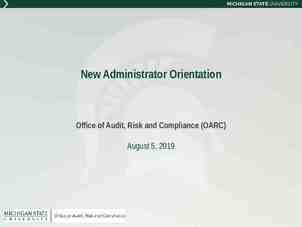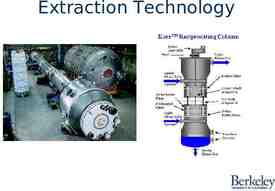The History of Earth Relative Dating Relative dating does NOT
20 Slides845.36 KB

The History of Earth Relative Dating Relative dating does NOT look for exact dates but instead looks for a sequence of events (order) – what came first Absolute Dating Absolute dating determines and age or age range, using chemical and physical properties of an object Carbon based objects can be dated by using carbon based radioactive dating

Absolute Dating : A Measure of Time Earth Science 8.2

Absolute dating Absolute dating Measuring the age of an event or object in years. Methods to determine the absolute ages of fossils and rocks Rate of Erosion Rate of Deposition Varve Count Radiometric Dating Carbon Dating

Rate of Erosion Rate of Deposition Determine how fast Determine age by the area has been eroded Reliable for features less than 10,000 years old Unreliable for older than 10K years old because the rate of erosion can be varied over millions amount of material deposited Not accurate only an estimate Deposits can vary based on natural events (floods)

Varve Similar to counting rings on a tree (dendrochronology) Varves are band of light coarse material & band of dark fine material. 1 year 1 varve Example: Winter can break down (weather) carry (erode) and deposit (deposition) coarse sedimentary rock which settles on the bottom of an area, then summer might bring the fine material. This will repeat and build over thousands of years. One band of light and dark material is a varve.

Radiometric Dating Using Radioactive decay to find out the age of material Rocks contain small amounts of radioactive material Energy is released the atoms change into different isotopes Scientists measure the concentration of the original isotope (parent) and the newly formed isotope (daughter) WHATS going on?!?!?!?

Radiometric Dating – from the top Most isotopes are stable, meaning that they stay in their original form. Other isotopes are unstable. Scientists call unstable isotopes radioactive. Radioactive decay Radioactive isotopes tend to break down into stable isotopes of the same or other elements. Isotopes atoms of the same element that have the same number of protons but different numbers of neutrons.

Because radioactive decay occurs at a steady rate, Scientists can use the relative amounts of stable and unstable isotopes present in an object to determine the object’s age. Dating Rocks — How Does It Work? In radioactive decay, an unstable radioactive isotope of one element breaks down into a stable isotope. The stable isotope may be of the same element or of a different element. Parent isotope The unstable radioactive isotope. Daughter isotope The stable isotope produced by the radioactive decay of the parent isotope.

The rate of radioactive decay is constant so scientists can compare the amount of parent material with the amount of daughter material to date rock. The more daughter material there is the older the rock is.

Radiometric Dating Radiometric dating Determining the absolute age of a sample, based on the ratio of parent material to daughter material. If you know the rate of decay for a radioactive element in a rock you can figure out the absolute age of the rock. Half-life the time needed for half of a sample of a radioactive substance to undergo radioactive decay. After every half-life, the amount of parent material decrease by one-half. (3/4 done at 2 half lives)

Types of Radiometric Dating Scientists use different radiometric-dating methods based on the estimated age of an object. There are four radiometric-dating techniques. 1. Potassium-Argon Method Potassium-40 has a half-life of 1.3 billion years, and it decays leaving a daughter material of argon. This method is used mainly to date rocks older than 100,000 years. 2. Uranium-Lead Method Uranium-238 is a radioactive isotope with a half-life of 4.5 billion years. Uranium-238 decays in a series of steps to lead-206. The uranium-lead method can be used to date rocks more than 10 million years old.

3. Rubidium-Strontium Method The unstable parent isotope rubidium-87 forms a stable daughter isotope strontium-87. The half-life of rubidium-87 is 49 billion years This method is used for rocks older than 10 million years. 4. Carbon-14 Method Carbon is normally found in three forms, the stable isotopes carbon-12 and carbon-13, and the radioactive isotope carbon-14. Living plants and animals contain a constant ratio of carbon-14 to carbon-12. Once a plant or animal dies, no new carbon is taken in. The amount of carbon-14 begins to decrease as the plant or animal decays. The half-life of carbon-14 is 5,730 years. The carbon-14 method of radiometric dating is used mainly for dating things that lived within the last 70,000 years.

Fossil Records – Clues to the Past Chapter 8.3

Key Terms Fossils: The remains or traces of plants and animals that live in the past (not yesterday the distant past a different geological time period) Paleontologist – cool guy (or girl) that studies fossils Index Fossils – Fossils that occur only in rock layers Fossilization – The process by which plants and animals are preserved against decomposition (usually the squishy parts decompose though)

Why are Fossils Important? Fossils reveal secrets of the past Organism development and evolution Climate & other environmental changes Index fossil are embedded in sedimentary rock layers & are used to determine age

How fossils form .or don’t BACTERIA is the enemy of fossil development. So are other animals If dead organisms are not protected by an environmental factor, bacteria will break down the organism and it will decompose Animals may come and see the dead organism as an easy meal

Formation methods Mummificati on Occurs in dry places Most bacteria does not survive well in these areas Generally lack internal organs Exception: Bog Bodies – many have preserved skin and organs Egyptia n Bog Body Mummy Amber A covering of plant sap. Preserves very delicate Tar Seep features Area of petroleum covered by water Acts a trap when animals fall in Tar surrounds and preserves the animal

Freezing Petrification Little bacteria here – its Minerals, such as too cold Low temperature preservation Dinosaurs didn’t live in the cold, so finding one in Antarctica meant that is was once a warm mild area silica, calcite and pyrite replace the organic material and create a near perfect replica. 200 million year old tree found in Arizona

Types of fossils Trace Fossils Carbon Film No actual organism A “picture” or is left behind, only an imprint. residual printed into the stone

Gastroliths Smooth stones found Molds & Casts Shells press into a soft muddy area which eventually hardens, the shell fills with mud, once the shell decays, the cast & mold are left behind by prehistoric remains Used to help grind and digest food (like a bird uses) Coprolites Can we say poopy? – coprolites are petrified waste material which can be used to determine feeding habits






